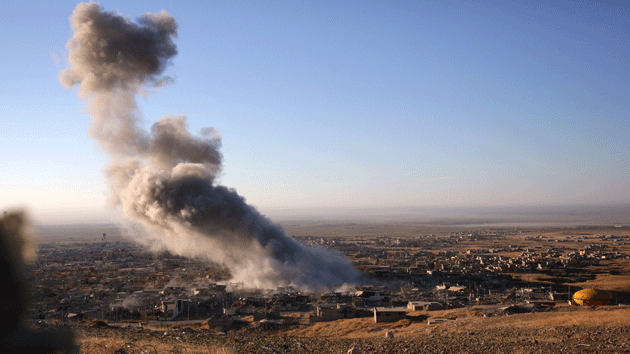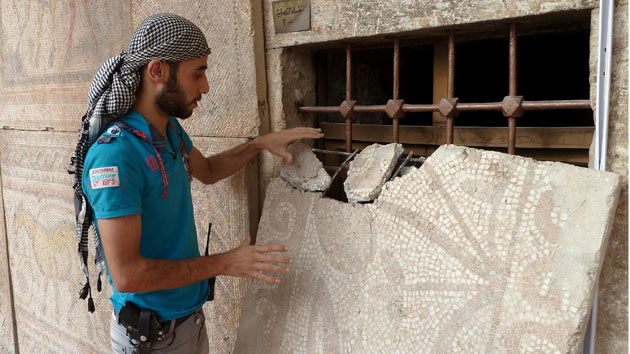
Smoke from an apparent airstrike billows over the northern Iraqi town of Sinjar on November 12, 2015.Bram Janssen/AP
Asked about his critics’ calls for the United States to use more force in its air war against ISIS, President Barack Obama rejected the idea of expanded airstrikes in an interview with NPR on Monday. “If the suggestion is is that we kill tens or hundreds of thousands of innocent Syrians and Iraqis, that is not who we are and that would be a strategy that would have enormous backlash against the United States,” he said. He also questioned the idea of “carpet bombing” ISIS, which had been suggested by Republican presidential candidate Sen. Ted Cruz (R-Texas). “You bomb ISIL,” Obama said, using the administration’s preferred acronym for the so-called Islamic State. “You’re not trying to bomb innocent people.”
However, the United States may be bombing more innocent Syrians and Iraqis than it cares to admit. In the 17 months since it started bombing ISIS and other jihadist organizations in Syria and Iraq, the US military has conducted more than 8,600 airstrikes and dropped 28,000 bombs. It reports killing 20,000 ISIS members, while causing just six civilian deaths, including those of three children—a claim that groups watching the conflict say is a gross undercount.
The Pentagon’s civilian casualty figure is dwarfed by those of widely cited monitoring groups that tally casualties from the conflict in Syria. They claim that a more accurate count of noncombatant deaths from US-led airstrikes is well into the hundreds. The Violations Documentation Center (VDC), a monitoring group with on-the-ground reporters in Syria, claims 302 civilians have died in the airstrikes. The Syrian Network for Human Rights has confirmed 251 deaths, including those of 75 children. Airwars, a British-based monitoring group that uses a range of sources including organizations that confirm the identities of the dead through relatives and local officials, states that the number of civilian deaths could be as high as 1,073.
Referring to the VDC’s figures, Patrick Ball, the executive director of the Human Rights Data Analysis Group, notes, “We should ask which group—Centcom or VDC—is more likely to have better access and stronger trust needed for documentation in the affected region. If we think VDC has better access and stronger trust, which I suspect, they’re likely to have a more complete count than Centcom.”
Citing “operational security,” US Central Command, which oversees Operation Inherent Resolve, will not disclose how it investigates or confirms civilian casualties. “A full-on investigation can be a little bit difficult because we don’t have access to a lot of these places in Syria and Iraq,” concedes Centcom spokesman Captain Bryant Davis.
Yet US military officials apparently receive enough on-the-ground information to regularly cite the number of ISIS militants who have been killed in air strikes. The United States claims to be killing an estimated 1,000 Islamic State militants a month, including “one mid- to upper-level ISIL leader every two days.” In early December, a series of strikes killed approximately 350 ISIS fighters as Iraqi forces pressed an offensive in Ramadi, according to the Pentagon. Its official body counts occasionally include the names of ISIS figures, such as Abu Salah, the Islamic State’s financial chief in charge of its extortion activities, and Hajji Mutazz, a deputy to the leader of ISIS. When asked how the military is able to accurately assess the number of militants it has killed but not the number of civilians, Davis replies, “This topic is a hard one, because we don’t have a whole lot to provide.”
Davis says the Pentagon will open an investigation if reasonable evidence of civilian casualties arises. “As an investigation completes, we try to be as transparent as we can,” Davis says. He points to two recently declassified reports that confirm six civilian deaths from two air strikes. One investigation into a series of attacks targeting the Khorasan group in the Syrian village of Harem on November 14 notes that they “likely led to the deaths of two non-combatant children.” Though further details are heavily redacted, the report does include images of the target location—a building in a residential neighborhood—and evidence gathered on the attack from the Syrian Network for Human Rights. The other report summarizes the results of an investigation into the destruction of an Islamic State checkpoint in Hatra, Iraq, on March 13. That strike, in which a single GBU-38 bomb was dropped on a guard shack, killed four noncombatants. The report cites “three execution errors” in achieving zero noncombatant victims (“NCV=0”), but details of those mistakes have been redacted.
Centcom goes out of its way to reiterate its rules of engagement, which are intended to minimize harm to civilians by using precision-guided weapons and picking targets carefully. For example, military planners have long known that the Islamic State uses the city hall in Raqqa, its de facto capital, as an administrative center and dormitory for fighters. They have decided not to target it because the three-story building also contains a jail that houses scores of what are mostly civilians that have been imprisoned by ISIS.
But the rules of engagement are changing. In October, Lt. General Bob Otto, the Air Force’s deputy chief of staff for intelligence, surveillance, and reconnaissance, noted that the coalition was “challenged in finding enough targets that the airplanes can hit that meet the rules of engagement.” On November 19, Defense Secretary Ashton Carter told MSNBC that the US military was prepared to loosen its rules of engagement to expand the array of targets in its air campaign. A week earlier, airstrikes on ISIS’s oil infrastructure began to target tankers, which previously had not been targeted because, as spokesman Colonel Steve Warren explained, “The truck drivers, themselves, probably not members of ISIL. They’re probably just civilians.” The day Carter spoke of easing the rules of engagement, Warren reported that strikes from A-10 Thunderbolts and AC-130 gunships had destroyed 116 tanker trucks. Forty-five minutes before the strike, leaflets were dropped, reading, “Get out of your trucks now, and run away from them.”
The latest reports of civilian deaths came earlier this month, when a monitoring group claimed that US airstrikes on the village of al-Khan in Syria’s Hasakah Province killed no combatants but 26 civilians, including seven children. Asked about the incident, Centcom spokesman Davis sent an email: “We are reviewing any information we have about the incident near Al Hawl…If the information supporting the allegation is determined to be credible, we will then determine the next appropriate step.”
















